Development of a Graphene-Carbon Composite: An Alternative to Metals and Plastics used in the Production of Pyramidal Satellite Horn Antenna
Authors: Adegbola, J.O., Alli, O.D., Akingbade, T.O., Ojetoye, A.A., Sanni, J. And Ajala, O.M.
DOI Info: http://doi.org/10.5281/zenodo.12599754
ABSTRACT
A radio wave is collected and transmitted in space using a pyramidal horn antenna. It is a waveguide horn with a pyramidal form that gathers radio waves and causes them to spread out like a beam. Although they are composed of plastic and metal, this pyramidal satellite antenna horn is beneficial for wide bandwidth applications. Finding an alternative to materials employed in the production of a pyramidal satellite horn antenna spurred the interest of this study. Graphene and carbon powders composite was considered and investigated to determine the mechanical and microstructural properties. The graphene percentage was varied while the carbon powder remained constant. The graphene-carbon composite materials were prepared using the open mold technique. Testing of the materials followed subjecting the samples to curing for 24 hours. The study showed that samples with higher graphene content exhibited better mechanical and microstructural properties. It was observed that the graphene content influenced the density and strength of the composite material. Graphene-carbon composite materials can make an excellent candidate for the production of a pyramidal satellite horn antenna.
Affiliations: Department of Mechanical Engineering, Adeleke University, Ede, Osun State, Nigeria.
Keywords: Composite Material, Curing, Density, Strength, Graphene
Published date: 2024/06/30









